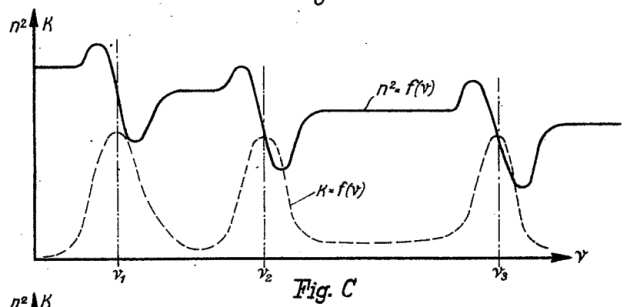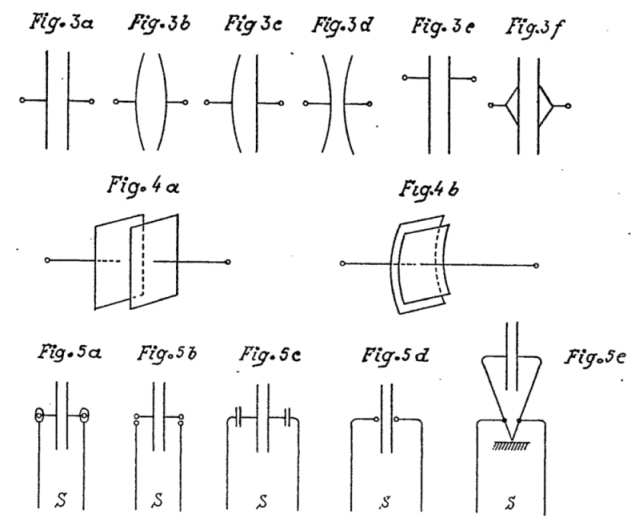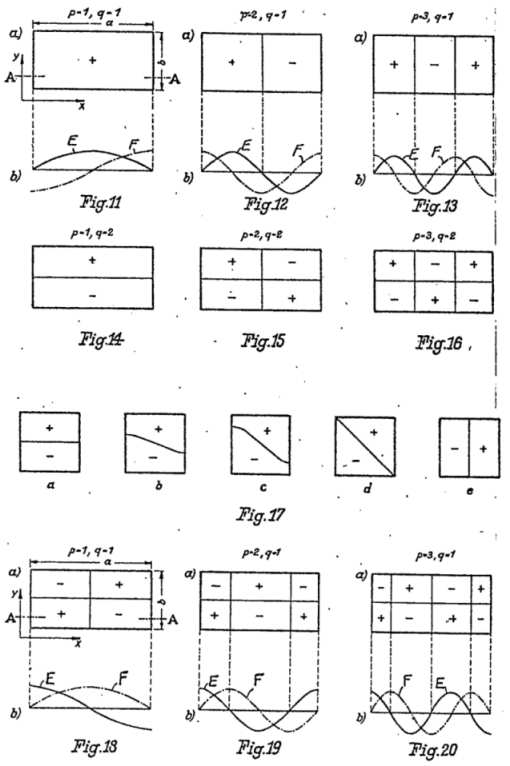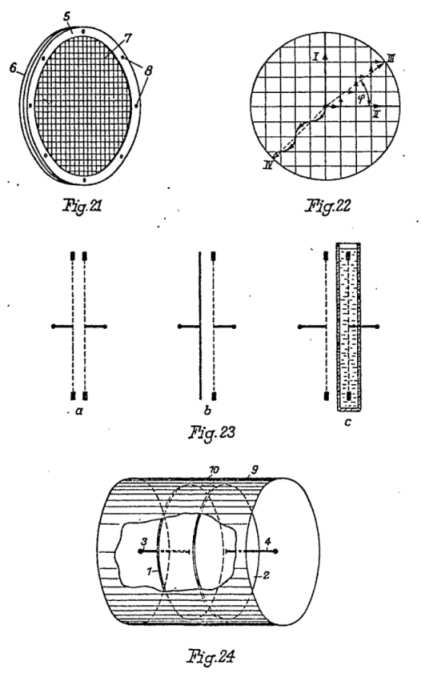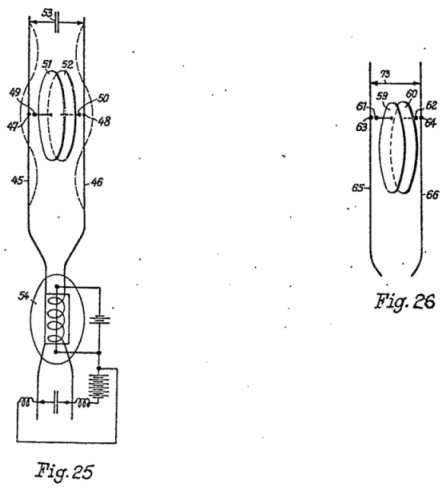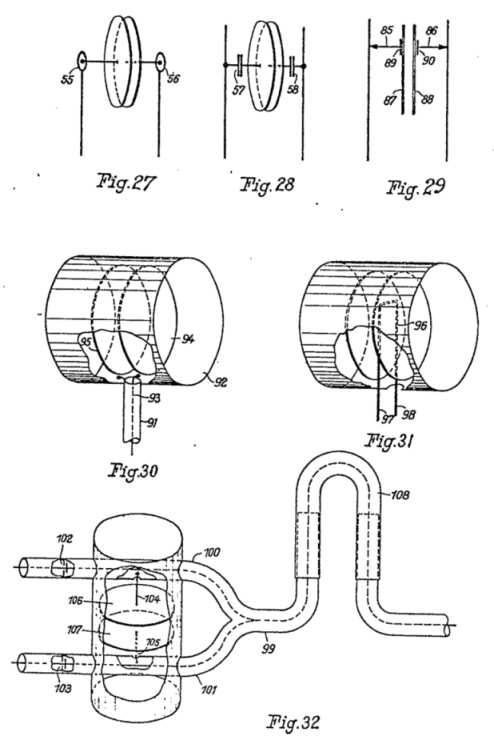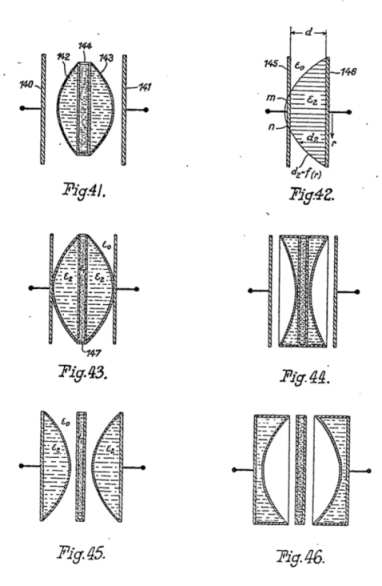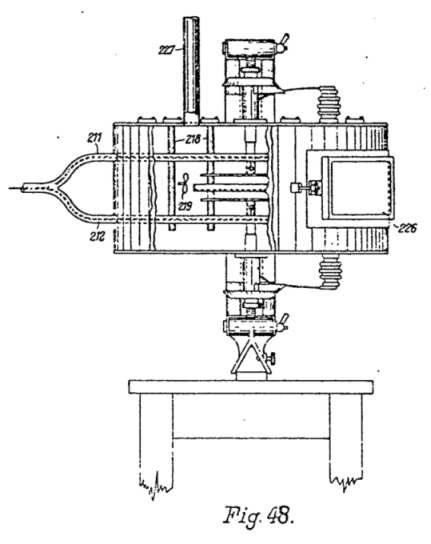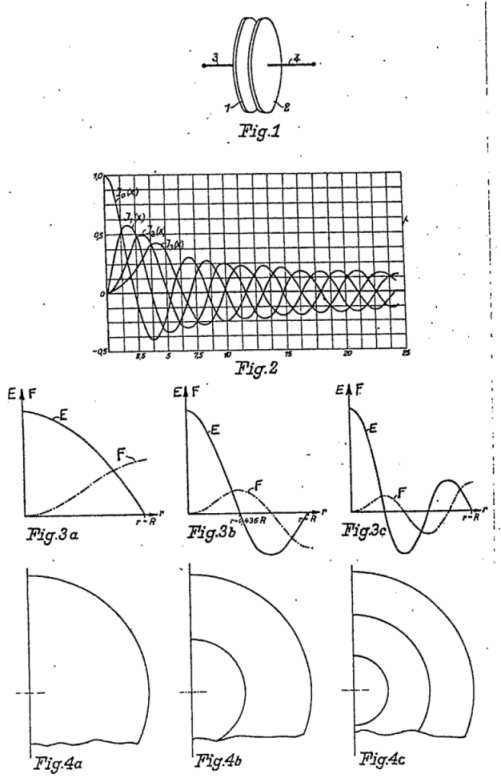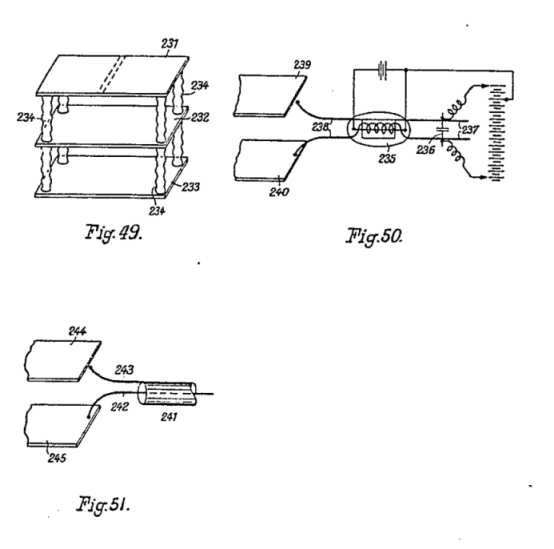James Y. JOHNSON
Dipolar Resonance / Anomalous
Dispersion Mutation
British Patent # 417,501
GB417501
[ PDF ]
Process for Altering the Energy Content of Dipolar
Substances
James Y. JOHNSON
Applicant: TERNION
AG
1934-09-28
Abstract -- Changes in the
energy content of dipolar substances are produced by exposure to a
concentrated electromagnetic field having one or more frequencies
corresponding to wavelengths between 3 mm. and 6 metres
approximately and equal to characteristic periods of the
substances treated. The process applies to naturally dipolar
substances and to those in which dipoles can be induced by a
field. The characteristic periods of the substances are of three
kinds depending respectively on (1) the relaxation time of the
dipoles when orientated by the field, (2) the natural
oscillation-period of the dipoles, (3) the term-difference
frequencies of the atoms. They are associated with anomalous
variations in the optical and dielectric properties and can be
found by examining those properties in a field of varying
frequency. They can be varied within limits by changing the
temperature, pressure, concentration, &c., and may thus be
adjusted to correspond exactly with a field of approximately
correct frequency. The fields may be standing ones produced
between conductors such as concentric tubes or the plate
resonators described in Specification 417,564, or radiated fields
concentrated by reflectors. They may comprise several different
frequencies and constant electrostatic fields may be superimposed
on them. The exposure may be continuous or intermittent and
different frequencies may be applied in succession. The invention
is not concerned with the production of merely transitory effects
and temperature changes, but with more permanent physical and
chemical effects of which the following are examples:-- Colloidal
dispersions and emulsions are stabilised or further dispersed by
short exposure but prolonged treatment produces coagulation. An
agar-agar gel exposed to a field of 116 cm. wavelength increases
in mobility after 10 minutes and becomes more viscous after
several hours. Crystallization is stimulated by the use of a
varying field. Preservation of organic materials is effected
preferably by intermittent exposure, e.g. veal after 3 minutes
treatment with a field comprising four selected frequencies
remains fresh for 2 weeks, or longer if further exposure to a
weaker field is given for 5 minutes in each hour. Milk and apple
juice may be similarly treated. Medical diagnosis and treatment.
Cell-division may be stimulated and other beneficial effects
produced in living bodies. The method of determining the
characteristic frequencies of the constituents of a living body
provides a means of diagnosis. Fermentation processes and other
processes involving bacteria may be modified by influencing the
bacteria or their nutrient medium. Germination of seeds may be
accelerated. Bean seeds previously swollen and exposed for 30 sec.
to suitable fields germinate twice as fast as untreated seeds.
Electrets may be produced by subjecting a fluid dielectric to a
field and then solidifying it by freezing, evaporation, or
coagulation. Medicines for internal and external use may have
electrets incorporated in them, the electrical energy being
released upon their application. A plaster comprising euphorbium
powder, fine resin, yellow wax, and turpentine may be exposed at
85 DEG C. to a field of 235 cm. wavelength and then cooled to 15
DEG C. Disinfecting pastilles comprising beeswax and gums and the
usual drugs may be similarly treated. Photographic plates may be
rendered more sensitive especially in the red and infra-red by
exposure to the fields. Chemical reactions may be promoted and
facilitated. Examples are: (1) the conversion of acetylene, steam,
and ozone into acetic acid and acetaldehyde without a catalyst;
(2) the drying of lacquers and varnishes; (3) the consolidation of
styrol; (4) the hardening of Bakelite; (5) the polymerization of
isoprene; (6) the vulcanization of rubber. Artificial silk may be
stabilized by treatment as it leaves the spinning
nozzle.ALSO:Chemical reactions are promoted or accelerated by
exposure of dipolar substances to a concentrated electromagnetic
field having one or more frequencies corresponding to wave lengths
between 3 mm. and 6 metres approximately and equal to
characteristic periods of the substances treated. The process
applies to naturally dipolar substances and to those in which
dipoles can be induced by a field. The characteristic periods of
the substances are of three kinds depending respectively on (1)
the relaxation time of the dipoles when orientated by the field;
(2) the natural oscillation-period of the dipoles; (3) the
term-difference frequencies of the atoms. They are associated with
anomalous variations in the optical and dielectric properties and
can be found by examining these properties in a field of varying
frequency. The fields may be standing ones produced between
conductors such as concentric tubes or the plate resonators
described in Specification 417,564, [Group XL], or radiated fields
concentrated by reflectors. Several different frequencies may be
applied simultaneously or in succession and either constantly or
intermittently, and constant electrostatic fields may be
superimposed on them. The following examples of reactions are
mentioned, viz.:-- Synthetic rubber is produced by polymerization
of isoprene. Phenol-aldehyde condensation products, styrol,
&c. are hardened. The drying of lacquers, varnishes &c. is
accelerated. Acetaldehyde and acetic acid are obtained by the
reaction of acetylene, steam, and ozone without a catalyst.
Artificial silk is hardened by treatment of the material as it
leaves the spinning nozzles. The product shows increased
resistance to wear. ALSO: The germination of seeds is accelarated
by exposure to a concentrated electromagnetic field having one or
more frequencies corresponding to wave lengths between 3 mm. and 6
meters approximately and equal to characteristic periods of the
substances treated. The characteristic periods of the substances
are associated with anomalous variations in the optical and
dielectric properties and can be found by examining these
properties in a field of varying frequency. The fields may be
standing one produced between conductors such as concentric tubes
or the plate resonators described in Specification 417,564, [Group
XL], or radiated fields concentrated by reflectors. Several
different frequencies may be applied simultaneously or in
succession and either constantly or intermittently and constant
electrostatic fields may be superimposed on them. According to an
example, bean seeds previously swollen are treated for 30 seconds
at 35 DEG C. with a field comprising wave lengths of 28 cm. and 87
cm. In four weeks they grow twice as much as untreated seeds.
ALSO: Changes in the energy content of dipolar substances are
produced by exposure to a concentrated electromagnetic field
having one or more frequencies corresponding to wavelengths
between 3 mm. and 6 metres approximately and equal to
characteristic periods of the substances treated. The process
applies to naturally dipolar substances and to those in which
dipoles can be induced by a field. The characteristic periods of
the substances are of three kinds depending respectively on (1)
the relaxation time of the dipoles when orientated by the field;
(2) the natural oscillation-period of the dipoles; (3) the
term-difference frequencies of the atoms. They are associated with
anomalous variations in the optical and dielectric properties and
can be found by examining these properties in a field of varying
frequency. The fields may be standing ones produced between
conductors such as concentric tubes or the plate resonators
described in Specification 417,564, or radiated fields
concentrated by reflectors. Several different frequencies may be
applied simultaneously or in succession and either constantly or
intermittently and constant electrostatic fields may be
superimposed on them. Medical diagnosis and treatment.
Cell-division may be stimulated and other beneficial effects
produced in living bodies by exposure to the fields. The method of
determining the characteristic periods of the constituents of a
living body provides a means of diagnosis. Medicines for internal
and external use may comprise electrets made by subjecting a fluid
dielectric to a field and then solidifying it by freezing,
evaporation, or coagulation. Their electrical energy is released
upon their application. A plaster comprising euphorbium powder,
pine resin, yellow wax, and turpentine may be exposed at 85 DEG C.
to a field of 235 cm. wavelength and then cooled to 15 DEG C.
Disinfecting pastilles comprising beeswax and gums and the usual
drugs may be similarly treated. Fermentation processes and the
like may be modified by influencing the bacteria or their nutrient
medium.
I, James Yate Johnson... do hereby declare the nature of this
invention ( which was communicated to me from abroad by Ternion
Aktiengesellschaft, of Glarus, Switzerland ), to be as follows :--
Among the properties of substances there are several which are
dependent on the frequency of the electromagnetic oscillations
used for observation. Among such properties may be mentioned for
example speed of transmission, absorption, rotation of plane of
polarization and dielectric constant. The term used in these cases
is dispersion of the properties concerned. In order to explain
this phenomenon, Sellmeier (1871) and later Helmholtz, Ketteler
and others developed the theory that with respect to the period of
oscillation employed the substances can no longer be regarded as
cpontinual, but rather they must be regarded as more or less
rigidly coupled aggregates of oscillators. As oscillators
according to modern conception of the construction of materials
may be mentioned the combined electrons, the combined atoms and
the dipolar molecules. Since these particles are carriers of
electric charges, they are set in oscillation under the influence
of external electrical alternating fields, as for example the
electromagnetic radiation field. They absorb energy from the
applied alternating field. The excitation is especially strong and
the absorption of energy therefore especially great in the case of
resonance. Simultaneously with this there takes place a sudden
change in all those properties which are connected with the
energetic alternating action between oscillator and external
oscillation, for example the above-mentioned properties. A typical
resonance curve is shown in Figure 1. The oscillation frequencies
are given as abscissae and the ordinates are the corresponding
strengths of the absorption of energy (dotted) and the values of
any one of the dispersion properties, as for example the
dielectric constant (full line). The region of the sudden change
is termed the anomalous dispersion region, in constrast to the
regions of normal dispersion on the branches of the curve lying
further to the outside.
In many cases, for exampe when it is desired especially to
emphasize the electrical nature of the alternating action the term
polarization of the substance is also used, in order to express
the polar structure of the oscillators.
In order to be able to state into which forms the absorbed energy
is converted, it is necessary to bring the conception of
polarization into a somewhat more precise form. It is preferably
subdivided into:
1. an electron polarization, i.e., an influencing of the electron
shells which build up and hold together the atoms;
2. an atomic polarization, i.e., a displacement of the position of
the atoms which build up the molecule, and
3. an orientation polarization, i.e., a change in the relative
positions of the molecules themselves.
The energies to be employed for the different polarizations are of
quite different orders of size. The greatest energy for
polarization is required by the electrons, the least by the
molecules. Now according to the quantum theory the following
equation holds good:
energy = h.v
in which h represents
the Planck elementary quantum and v represents the frequecny of oscillation of the
electromagnetic rays. Thus the greater the energy to be introduced
into the particles of matter, the greater must be the frequency of
oscillation of the rays, and the shorter therfore must be their
wavelength. Accordingly the resonance positions of electron
polarization lie in the region of the Roentgen, ultraviolet and
light rays, the resonance positions of atomic polarization lie in
the region of the infrared spectrum and the resonance positions of
orientation polarization lie still further beyond in the region of
the radio short and ultra-short waves. Those which have been best
investigated are the absorption spectra in the region of visible
light. It is known therefrom that the absorbed light causes no
appreciable physical or chemical changes in the irradiated
substance. it is to the greater part radiated again as such. A
part is converted into heat, another part may serve, with a change
in its wavelength, to excite atomic oscilaltions (Raman effect)
and in comparatively rare cases the rays of light passing into the
substance give rise to chemical changes (photochemical reaction).
The rareness of photochemical reactions is especially prominent.
The behavior in the IR region and in the UV region is very
similar.
Only a little is known of the behavior of substances with respect
to waves having a wavelength of from the IR to several meters. The
anomalous dispersion bands, especially, have still scarcely been
exactly investigated. The region of waves which has hitherto been
well investigated lies above about 2 meters, which is, generally
speaking, outside the anomalous dispersion bands. The dielectric
polarization is only slightly noticeable therein. Energy is
absorbed only slightly and since it is moreover almost completely
converted into heat, is generally unsatisfactory, so that
dielectric losses are spoken of. Only in a few special cases can
this polarization be usefully employed (diathermy, Kerr
celss).
My foreign correspondents have now found that dipolar substances
and substances containing the same behave in a thoroughly new and
unforeseen manner when they are subjected to the action of an EM
radiation field which oscillates mainly or wholly in one or more
frequencies of the said substances in the region of waves of from
the infred to several meters in wavelength. The term "natural
frequency" is intended to mean the range of frequency of the
anomalous dispersion. Especially profiound influences take place
by the action of alternating fields which correspong to the
natural frequencies of the substance which lie below 2 meters. By
this action, an alteration in the energy content of the dipolar
substance takes place which becomes strikingly noticeable in an
increased reactivity and an orientation of the molecules. The
orientation of the molecules renders the substances double
refractive. This double refraction also effects a rotation of the
plane of a ray of polarized light passed therethrough.
Before entering into details of this phenomeon, some observations
may be made on the determination of the natural frequencies. From
the previously described connection between resonance frequency
and anomalous dispersion position it results that the latter is a
suitable indicator for the resonance frequency. It is only
necessary to follow the frequency dependence of a constant of a
substance suitable for the range of waves concerned up to the
anomalous position. The dielectric constants are especially
suitable for this purpose. My foreign correspondents have found
that there are two sharply separated kinds of anomalous dispersion
which may be differentiated as friction dispersion and resonance
dispersion. Friction dispersion appears in all non-conducting
dielectrics. With water
for example it is shown in Figure 2, wherein the curves shows the
course of the dielectric constant when using varying wavelengths
for observation, and exhibiting a band of anomalous dispersion at a wavelength of about 1.5
centimeters.
The course of such functions has already been theoretically
explained by Debye and brought into mathematical form. In the
description, the time lag
appears as a substantial constituent of the conception, i.e., the time which the molecules
require in order to come into equilibrium with an external field.
The time lag is, inter alia, dependent on the internal friction
constant and the temperature.
In order to tune the irradiation alternating field and the
natural fequency of the substance to be treated to each other, the
external frequency may be
altered while keeping the time lag constant until resonance is
attained, or the time lag may be
altered while keeping the external frequency constant.
The latter may be conveniently attained by altering the internal
friction, i.e., by alteration of
the concentration and/or temperature.
Resonance dispersion appears in all conducting dielectrics, i.e.,
in electrolytes. it is of special importance for the processes in
living organisms. its curve differs very clearly from that of the
friction dispersion, as may be seen from Figure 3 of the
accompanying drawing. The band of anonmalous dispersion is very
small and sharply pronounced, frequently scarcely wider than
delta lambda = 2 / 100 lambda.
It can consequently be very readily overlooked. This hitherto unknown dispersion
anomaly is connected with the alternating action of the ions.
In order to determine the natural frequency of dipolar substances
and to alter the energy content of these substances, thereby
allowing the technical effects hereinafter described to be
obtained, electromagnetic fields in part of relatively small field
strength but also in part of great field strength are necessary...
In order to strengthen the action of the electromagnetic fields
thus produced they may be directed and concentrated by known
means. This is especially of importance in cases when it is
desired to carry out the action only in certain zones. A direction
of the field may be effected by reflectors and a concentration may
be effected between Hertz parabolic mirrors. Extremely
concentrated fields may be produced by a new apparatus which is
the object of the copending application No. 11,628/34 ( Serial no.
417,564 ). This describes a plate oscillator which resembles a
condenser in its external form, but not in its electric behavior.
In one of the modes of execution which are adequate for use in
practice, it consists of two plates oppositely arranged. By reason
of the distributed self-induction and distributed capacity the
plate oscillator has electric resonances which appear at very high
frequencies.
In order to bring into action the electromagnetic alternating
fields corresponding to one or more natural frequencies of the
dipolar substance, the dipolar substance is brought, according to
the desired intensity of the action, into the EM alternating field
of corresponding frequency which may be undirected, or dirrected (
e.g. by reflectors ), or concentrated ( e.g. by Hertz mirrors),
or, if a specially intense action is necessary, the dipolar
substance is exposed to the stationary alternating field in thin
layers between the electrodes of the plate oscillator.
In cases when a substance has several natural frequencies in teh
range concerned, such as is the case mainly in electrolyte
mixtures, a tuning may also beeffected with the aid of means known
in high frequency technique...
The energy supplied by resonance excitation varies wither the
intermolecular or intramolecular equilibrium of the substance
depending on the radiated natural frequency or on the intensity
thereof. In the case of colloids
for example the influencing of the intermolecular fields of force
results in a change in the size
of particles ( conversion from the sol into the gel conditions
or vice versa, floculation, change in the ciscosity or
consuctivity and the like ) or in a change in the degree
of hydration ( influencing of the ageing phenomena of colloids, as
for example silica gel, albumens, pectins and similar colloids).
In order to illustrate the effects taking place in colloidal
solutions by irradiation with electromagnetic alternating fields
having a frequency which corresponds with a natural frequency of
the orradiated solution, an experiment carried out with a colloidal solution of gold is given
below. The solution showed a maximum resonance with a wavelength
of 18.6 cm and at about 20* C. The solution was
interposed in a layer 1 millimeter in thickness between the
circular plates of a plate
oscillator with a plate diameter of about 6.2 cm was at a
wavelength of 18.6 cm... After acting on the solution for
an hour, the original red color of the solution changed to orange,
a change in color which as is well known indicated a diminution in the size of the
colloid particles. By intensive irradiation for longer periods
an opposite effect is observed, a floculation takign place.
For further illustration an experiment carried out with agar-agar solution the
resonance position of which lay at a wavelength of 116 cm may be referred to. These
longer waves require plates of considerably larger diameter for
the purpose of tuning the plate oscillator. Wth the plates 1 cm
apart, plates having a diameter of nearly 30 cm are necessary, as
determined by calculation and confirmed by experiment in order
that the fundamental wave of the oscillator has a wavelength of
116 cm. In order to avoid these somewhat troublesome dimensions,
the experiment was carried out in a plate-oscillator in which the
distance between the plates was reduced from 1 cm to about 0.5 cm,
whereby it was possible to employ circular plates havin a diameter
of 20 cm. The fine tuning of the oscillator system to the dipolar
layer ( having a thickness of 1 mm and a natural frequency of 116
cm ) interposed between the plates was effected by regulating the
distance between the plates... After a short time the solution
became more mobile,nad after irradiation for several hours the
opposite effect occurred and the solution became more viscous.
The effects in the case of colloids of living organisms are
especially striking, where they are equivalent to a preservation.
For example by suitable dosing of the intensity of radiation
the natural decomposition processes, which always commense with a
decrease in the energy content and a change in the colloidal
state, may be suspended. For example if fruit of all kinds be irradiated with the natural
frequency of their expressed juices ( on an average 40 cm with slight deviations )
or animal products with the
natural frequency of their serums ( on the average from 85 to 95
cm ), a preservation
for weeks at ordinary temperature is obtained, whereas
the same products without irradiation are spoilt within a few days
under otherwise identical conditions. It is remarkable that the
natural aroma is completely retained in the case of
radiation-preservation. If the intensity of radiation exceeds the
degree necessary for preservation, profound chemical changes take
place.
By the action of EM alternating fields of frequencies which
correspond to one or more of the natural frequencies of the blood
serum, profound effects may be produced in men and animals.
Serums are thoroughly complex liquids in which is present a large
number of dipolar substances in more or less great dilution. The
solvent is water. The position and strength of the anomalous
dispersion bands varies according to the nature and concentration
of the dipolar substances. Experiments have shown that differences
in the position of the resonance positions occur not only in
different serums but also in serums taken from different
individuals. In fact even with one and the same individual, the
strength and number of the absorption bands differ according to
the prevailing condition of change-of-matter. Since the absorption
bands, espcially in the case of dipolar substances which are only
present in small concnetration, are in part extremely sharp (half
value widths of less than 5 %) they readily escape observation
when normal pure electrical methods are employed. The position of
the resonance points herein described has been found for example
by observing the alteration of the intensity of a beam of
polarized light penetrating the influenced substances.
In the said manner the serum of a a test person was investigated.
At a temperature of 37* C
an especially strong pronounced resonance position was established
at a wavelength of about 90 cm.
Between this wavelength and the shortest dipolar resonance bands
occurring in the serum, that of chemically pure water which lies
at a wavelength of about 1.28 cm there are a large number of
characteristic resonance positions the accurate knowledge of which
might give a comprehensive conception of the state of health of
the person concerned. Resonance positions above a wavelength of
about 1 meter are according to observation made up to the present
rather wide. The supply of oscillatory energy from these long
ranges of waves leads chiefly to increases in temperature, but not
to the quite specific einfluences which are characteristic for
most of the resonance positions below a wavelength of 1 meter. By
irradiation with frequencies corresponding to the sharply
prodounced resonance positions, it is possible, as experiments
have proved, to cause quite definitive reproduceable effects. The alterations of energy in the body
lead to advantageous effects or also to marked injury.
If it is intended specifically to act on foreign bodies in the
serum, as for example bacteria, there are two possibilities;
either the irradiation is effected in the frequency which
corresponds to a strongly pronounced absorption position owing to
the presence of foreign bodies in the serum and thus the nutrient
medium and therefore, for example, the living conditions of the
bacteria are altered, or the irradiation is effected in
frequencies which correspond to the natural frequencies of the
dipolar substance from which the bacteria are built up.
Purely chemical reactions can also be enforced which otherwise
only proceed under the influence of heat or of catalysts. For
example isoprene is converted into a rubberlike polymerization
product, rubber solutions are vulcanized in the presence of
sulfur, Bakelite A adn B are converted into Bakelite C, varnishes
and laquers dry more quickly, acetylene combines with water to
form acetaldehyde which in the presence of oxidizing agents, as
for example ozone, is immediately converted into acetic acid, and
so forth.
A further effect to be observed by the action of resonant
eledctromagnetic alternating fields is that the dipolar molecules
are orientated. Such orientation of dipolar molecules which
ingeneral are in the disordered thermal equilibrium, could
hitherto only be produced by the action of an external
electrostatic field which due to the smallness of the dimensions
of the molecules must be very strong, in order to exert an
appreciable torque on the molecules and thereby orientate them.
For the orientation of dipolar molecules by means of electrostatic
fields voltages are necessary which nearly reach the disruptive
strength of the dielectrics and thus are of the order of about
between 100,000 and 200,000 volts. Consequently an oritentation of
conductive dielectrics by means of electrostatic fields is not
possible since in such dielectrics the fields break down.
In contradistinction thereto, conductive as well as non-conductive
dipolar substances can easily be orientated by means of resonant
electromagnetic alternating fields. At first glance this appears
to be improbable since it is to be assumed that the molecules will
change periodically their direction in phase with the alternating
field or rotate in the same phase and not arrange in the preferred
position. This assumption would be correct, if the molecules did
not exert directed forces on each other. Such directed forces,
however, are existent as results from the fact that without any
external influences the single molecules orietnate themselves to
some extent on their neighboring molecules while passing through
the sphere of influence of the latter as can be observed in x-ray
spectrograms. The same forces are also the cause of the formation
of associates of molecules as can be observed in many cases, for
example of pairs of molecules, as in the case of acetic acid,
shoals of molecules as with azoxyanisole, or the accumulation of
dipolar molecules around an ion as is the case with hydrated ions.
Such associates are liable to form groups by interlocking.
The formation of such associates essentially depends on the
frequency of collisions of two molecules, the greatness of the
intermolecular forces and the probability of the collision of two
molecules in a positin favorable for the formation of associates.
By setting the molecules in uniform oscillation by means of a
resonant eM alternatig field the probability of the molecules
colliding with each other in a position favorable for the
formation of associates and the permation os such associates and
groups of interlocked associates is essentially increased. Such
associates and groups are no longer capable of following the phase
of the applied alternating field, but can only exert tilting
oscillations about a position determined by the applied alternting
field. This, howver, is equal to an orientation of the molecules
throughout the whole mass. An electrostatic ( ES ) field acting
simultaneously with the alternating field and in parallel
therewith has no great influence on the orientation process for
the reason already stated. It may, however, help to increase the
percentage of orientated molecules and to keep a body of molecules
which have once been oriented, in the ordered condition, even when
the alternating field is withdrawn, since it is no longer
necessary to orientate a body of disordered molecules requiring a
high voltage, but prevent a body of orientated molecules
substantially supporting itself to fall back into the disordered
condition. For this purpose an ES field is sufficient, the voltage
of which is from 10 to 20 times smaller than is necessary to
produce such orientation by means of an ES field alone.
After withdrawing the applied resonant alternating field by which
the orientation is produced, the disordered thermal equilibrium is
produced again. The orientation may be maintained, however, if the
dipolar substnace, while being orientated, be converted into a
solid state the orientation being thus "frozen in", so to speak.
This may be attained by solidifying an orientated gelatinizable
dipolar substance or a gelatinizable liquid in which an orientated
dipolar substance is dissolved, or by cooling an orientated
dipolar substance below its melting point, or by evaporating the
solvent in which an orientated solid dipolar substance has been
dissolved. Such "freezing in" of an orientated substance in the
said manner can only effected while maintaining the resonant EM
alternating field alone, if the solidification takes place without
change of temperature or concnetration, that is to say if during
the solidification the alternating field and molecules do not come
out of phase by change of the time lag. This is the case if the
solidification be effected by gelatinization at constant
temperature. When producing solidfication by cooling or
evaporating of a solvent the orientation must be maintained by
means of an electrostatic field since during the solidifying
process the time lag of the molecules is changed. In the latter
case the EM alternating field by which the orientation is produced
may be withdrawn. The maintenance of an orientation proceeds
especially well when particularly long-chained molecules (grerat
time lag) are embedded in an amorphously solidifying melt.
Mixtures of paraffin and wax or glycerine with wax or colophony
were investigated in this way. The value of the mean surface
density of the permanent orientation charge amounted for exmaple
to 0.5 to 2.0 x 10^9 coulombs per square cm positive.
A substance have a frozen-in orientation of its molecules is more
rich in energy than the same substance in natural thermal
equilibrium. When "thawed" it gives up again this excess of
energy, and, indeed, in the form of radiations of the same
wavelength as those with which it was origianlly orientated. This
behavior may be used in order to supply to animal bodies dosed
amounts of energy of a natural frequency which is active in the
organism, as for example by allowing an aqueous gelatin the
natural frequency of the serum to solidify while orientated and
then to incorporate it into the body in this form...
Complete Specification
This invention relates to a process for altering permanently as
well as temporarily the energy content of dipolar substances by
exposing them to rapidly oscillating EM fields.
By dipolar substances are meant, not only those that contain
dipoles in the absence of an electric field, but also those in
which dipoles are induced when the substance is exposed to a
suitable electric field. Dipole is used in the sense familiar in
connection with the well known work of Debye, as expounded (for
example) in his book entitled "Polar Molecules" (1929).
It is known that the dielectric constant and certain associated
properties of a dipolar substnace are changed when it is placed in
an electric field. But such changes hitherto produced by electric
fields have been transitory and have vanished with the field. This
invention is not concerned with them except insofar as they are
necessarily associated with permanent alterations; by a permanent
alteration is meant one that endures for an appreciable period
after the substance has ceased to be exposed to the
electromagnetic field.
By an alteration in the energy content of a substance is meant one
that does not consist solely in a change in the temperature of the
substance or in a change enevitably consequent on change of
temperature. On the other hand in the process known as diathermy
the temperature of a substance which may be dipolar, is raised
permanently (in the above sense) by exposure to a rapidly
oscillating EM field. The object of the present invention,
however, is not to produce a rise of temperature, although it may
happen in certain isntances that the characteristic period or
frequency of a dipolar substance may be such that a rise of
temperature will inevitably occur in the course of the application
of the process of the invention.
The process with which this invention is concerned depends on the
fact that a dipoalr substance is characterized by one or more
definite periods and frequencies, which will be termed its
characteristic periods and frequencies. The chief of these
characteristic periods and frequencies, as explained more fully
below, are,
1. -- the relaxation time of the orientation of the dipoles when
exposed to a varying electric field;
2. -- the period of natural oscilation relative to each other of
the charges cosntituting a dipole;
3. differences of the terms ( in the spectroscopic sense )
characteristic of the atomic and molecular structure.
It has been found that permanent alteration of the energy content
of a dipolar substance can be produced by exposing it to an EM
field of sufficient intensity varying with a period or frequency
substantially equal to one of these characteristic periods or
frequencies.
The cahracteristic periods or frequencies most important for
the invention lie in the region of the spectrum corresponding ( in
the conventional sense ) to wavelengths between 3 mm and 6 meters,
but the use of periods of frequencies lying slightly outside these
limits is not outside the invention. The region of the spectrum
within which these periods or frequencies lie will be hereinafter
termed quasi-optical. Special methods are necessary to obtain EM
fields of sufficient intensity oscillating with these frequencies.
They cannot be obtained by setting into osciilation combination of
discrete condensers and self-inductances; for the dimensions of
the condenser or coil required are so small, and consequently the
volume in which a strong field is established is so small, that no
sufficient amount of the substance can be instroduced into it. On
the other hand two methods have been found of obtaining the
necessary fields over the necessary volume.
In one method conductors bounding the space in which the
substance is contained are set into natural oscillations in virtue
of their distributed capacity and inductance, so that standing
waves are set up within the race. Suitable conductors for the
purpose are a pair of concentric tubes or a plate-resonator, as
descried in the copending application consisting of opposed plated
excited into their modes of natural vibration. A field produced in
this method will be termed hereafter a "standing field".
In another method radiation of the appropriate frequency is
concentrated into the space containing the substance by means of
reflectors. A field produced by this method will be termed
hereafter a "radiating field".
The term "concentrated field" will mean a field produced by either
of these methods or by any other method which can produce fields
of the same frequency and intensity.
According to the invention a process for altering permanently the
energy content of dipolar substances comprises the step of
exposing the substnace to a concentrated EM field oscillating with
a quasi-optical period or frequency, such period or frequency
being substantially equal to one of the characteristic periods of
frequencies of the substance. It is to be understood that the
oscillation of the field need not be sinusoidal, so that it has
only a single period or frequency; it may be of any wave form so
long as it contains at least one main component whose period or
frequency is susbtantially equal to one of the said characteristic
periods or frequencies.
The nature of the invention and the means for carrying it into
effect will now be described in greater detail.
The Characteristic Peridods and
Frequencies
The first step towards a better understanding of the nature and
scope of the invention is a discussion of the characteristic
periods and frequencies. Those denoted above by (1), (2), and (3)
will be discussed in order.
(1) The orientation of dipoles expodes to a varying electric field
is discussed at length in Chapters V and VI of Debye's book on
"Polar Molecules" above-mentioned. The following statement is in
principle a brief summary of his exposition.
The orientation of dipoles along the lines of force of an
electrostatic field is opposed by irregular motion arising from
random thermal agitation. If the field is steady, the perfection
of the orientation finally attained, and therefore the value of
the dielectric constant of the material, depends only on the
temperature, the nature of the dipoles, and the intensity of the
field. But if the field is varying rapidly, the dipoles will not
follow its variations accurately, their motions being hindered by
the mutual actions which give rise to the viscosity of the
substance. The dielectric constant depends therefore on the
relaxation time t, which
measures roughly the time that completely orientated dipoles take
to return to the completely unoriented state, under their thermal
agitation, when the field is removed. The relaxation constant is
given by
(1) t
= 4 pi a^3 n / KT

where a is the effective
radius of the dipoles, n
the viscosity. T the
absolute temperature and K
Boltzmann's constant.
The dependency of the relaxation time on the temperature T may already be pointed out
now as, among others, it offers the possibility of transferring
the place of anomalous dispersion into other ranges of wavelength.
The forces on which viscosity depends are dissipative and
accordingly orientation under a rapidly varying field is
accompanied by absorption of energy; the dielectric constant
epsilon ( e ) for
a field of frequency v
is therefore given by the formula:
(2) e
= n^2 ( i -- jk ) ^2
where n is the
refractive index and k
the absorption coefficient of the medium for EM waves of frequency
v, and

In Figure A of the
accompanying drawings, n2 and k are plotted against v, n2
being given by the full line and k by the dotted line ( k is here represented by ks ). As v increases, n2
decreases regularly and ke decreases as v increases, the decrease
being particularly rapid in the neighborhood of the maximum of k between the limits v1v2.
This decrease of dielectric constant ( and of refraction index )
with increasing v is
generally known as anomalous
dispersion.
The shape of the curves in Figure A depend, of course, on the
properties of the dipolar substance. In particular the scale along
the axis of v depends on
the relaxation time t.
For, as Debye shows, both n2k, insofar as they vary with the frequency owing
to the cause considered here, are functions of vt. Accordingly the value of
v at which the maximum of
k occurs is inversely
proportional or reciprocal to tt is therefore a
characeristic period, of the substance giving rise to a maximum of
absorption for oscillations having a corresponding period.
(2) The periods of natural oscillation of the charges of a dipole
give rise to a second kind of anomalous dispersion which is
completely analogous to that familiar in optics. It arises of
course from resonance. Figure B
shows the course of n2
and k which arises from
a natural oscillation of frequency vo ( k is here represented by kw ). Figure C shows the course when
there are several natural frequencies v1, v2, v3. Figure D shows the course when
a single natural frequency v0
falls in the range of anomalous dispersion of the kind shown in
Figure A between the limits v1,
v2.
The natural oscillations concerned here are of two main origins.
(a) Oscillations in electronic polarization, that is to say, the
displacement of electrons within the atom; (b) oscillations in
atomic polarization, that is to say, the displacement of whole
atoms within molecules or other permanent groups of atoms. As
well-known, the frequencies of oscillation (a) are almost all in
the optical region; they are important for the refractive index
for visible and ultraviolet light, but have hardly any effect in
determining the variation of the dielectric constant at the
quasi-optical frequencies with which this invention is concerned.
The charcteristic frequencies of the kind in the quasi-optical
range are those of the atomic oscillation (b). These frequencies
also determine maxima of absorption important for the present
invention.
It will be observed that the region of anomalous dispersion is
much narrower when a characteristic period of type (2) is involved
than when a characteristic frequency of type (2) is involved. This
may be one reason why type (2) has so far received less attention.
(3) The third kind of characteristic frequency cannot, like the
two considered so far, be explained in terms of classical
conception; it demands quantum conceptions. it is well known that
the discrete energy states in which alone any system can exist are
each associated with a "term"; that the transition from a state of
higher energy to one of lower energy is accompanied by the
emission of radiation whose frequency is the difference between
these terms; and that, conversely, the system can be raised from a
state of lower energy to one of higher energy by radiation having
that frequency, the radiation being absorbed in the process.
Accordingly a difference between terms is a frequency determining
absorption and, if it lies in the quasi-optical region, is a
characeristic frequency for the purpose of the invention.
Detection and Adjustment of
Characeristic Periods or Frequencies
The process according to the invention consists in exposing a
substance to a field of its characeristic period; and the
efficiency of the process depends greatly on the exact adjustment
of the period of the field to the characeristic period.
One useful means consists in examining the substance with
polarized light (or other known means) and so determining the
extent of its double-refraction when exposed to the field. Outside
the range of anomalous dispersion associated with characteristic
periods or frequencies of types (1) and 92), the double-refraction
depends on the intensity of the field, but is almost independent
of its frequency; but inside that range it varies with the
frequency. Accordingly by varying the frequency of the field and
observing where a variation of the double refraction occurs, the
position of a characteristic period or frequency of the types (1)
and 92) can be determined with great accuracy. The variations of
the dielectric constant with the frequency can, of course, be used
for the same purpose as indicated in Figures A and B.
When the characteristic periods or frequencies have been
determined, the frequency of the field may be adjusted to them. In
place of making an exact adjustment, the field may be roughly
adjusted and then modulated with a lower frequency, so that the
frequency of the field oscillates to and fro across the
characteristic frequency.
Instead of adjusting the period or frequency of the field to the
characteristic period or frequency of the substance, the latter
may be adjusted to the former. Thus, according to (1) the
relaxation time depends on the temperature; this characteristic
period can therefore be adjusted to that of the field by varying
the temperature. Changes in characeristic periods and frequencies
can also be produced by altering the relative concentration of two
components of a solution, or (particularly in the case of gases)
by altering their pressure.
Subsidiary Processes
Many of the effects produced by a process according to the
invention are probably due to the polarization of the dipoles,
originally existing or induced, whereby they arrange themselves
with their axis parallel to the field. Such polarization can also
be produced by constant fields. But the constant fields required
to produce those effects are often too large to be practicable. On
the other hand, it has been found that there is often an advantage
in superimposing a constant field on the field varying with the
characteristic period or frequency. The presence of the varying field greatly reduces ( e.g.
by a factor of 10 to 20 ) the constant field required to produce
a given effect; and the constant field, if maintained after the
varying field has been removed, will maintain the state of
polarization set up by the combined field.
The state of polarization can be prserved in another way. If,
after it has been set up, the viscosity of the medium is increased
greatly, the dipoles will be unable to return to the disordered
state by thermal agitation. Thus a liquid which has been polarized
may be frozen, or a solvent containing the polarized substance may
be gelatinized or removed by evaporation. This method of
preserving a state of polarization will be termed generally
"freezing". When a freezing operation is reversed, the state of
polarization is destroyed and the energy characteristic of it
liberated.
It must be understood that the process according to the invention
includes exposing a substance to two or more fields each varying
with a different characteristic period or frequency; the exposure
to these fields may be simultaneous or successive. If it is
successive, the time of exposure to the different fields may be
controlled by time relays.
Again exposure to the varying field may be a continuous process,
in whihc the substance is caused to flow, or otherwise to pass,
through the field; in this way it may be exposed to fields of
different strength at different points in its passage.
Application of the Process
A. Colloids
One of the most important applications of the process according to
the invention is to the dispersion and coagulation of colloidal
solutions. The effect of the polarization due to the field in
promoting these changes is in most case connected with hydration
of the dispersed particles and/or with changes of the hydrogen-ion
concentration. The first effect of exposure to te field is usually
an increase in dispersion; but a prolonged exposure may reverse
this effect and produce coagulation.
Thus a certain colloidal
solution of gold was found by the method described to
have a characeristic period corresponding to a wavelength of 18.5 cm. A layer of 1 mm thick
was exposed at a temperature of 20* C to a standing field fed by
valves giving an output of 0.1 watt. After one hour the original
red colour had changed to orange, indicating an increased
dispersion; after 2 hours the effect had been reversed and further
exposure produced coagulation.
Again an agar-agar gel with a characteristic period corresponding
to a wavelength of 116 cm was exposed to a field supplied by a
generator yielding 10 watts. After 10 minutes the mobility of the
gel had increased; but after several hours the effect was reversed
and the gel had become more viscous.
B. Preservation of Organic
Materials
The first stage in the ageing of an organic material is usually a
coagulation of a colloid. Accordingly by the process according to
the invention ageing may be prevented or even reversed, so that
the product is reversed. For the reason just explained, it is
necessary to adjust the time of exposure suitably; it has been
found that a discontinuous process, in which the substance is
alternately exposed and not exposed, is generally more effective
than continuous exposure to a field of lesser intensity.
Thus, 2 liters of cow's milk,
3 hours old, was exposed for 2 minutes to fields of each of five
frequencies. The wave lengths lambda and the power N of these
fields were: -- lambda1 = 455
cm, N1 = 230 watts ; lambda2 = 283, N2 = 160 ; lambda3 = 355, N3
= 160 ; lambda4 = 163, N4 = 23 ; V5 = 27.5 ; N = 0.6. The
temperature was originally 20* C and rose to 23 * C. The milk so
treated kept fresh for 28 days and could be preserved still
longer by exposing it for 5 minutes in each hour to a field of
the above wavelength with a total energy of 3.2 watts.
Again 2.5 kg of veal, 36 hours
old, was treated for 3 minutes with a field given ( as above by:
-- lambda1 = 468 cm, N1 = 250 watts, lambda2 = 362, N2 = 150,
lambda3 = 184, N3 = 10, lambda4 = 92.5, N4 = 3. The temperature
rose from 20* C to 24.5* C. The meat remained fresh for 2 weeks
and could be kept still longer by exposing it for 5 minutes in
each hour to these wavelengths with a total power of 3 watts.
Again, 2 liters of apple juice
was exposed for 1-1/2 minutes to a fiield given by: -- lambda1 =
475 cm, N1 = 200 watts, lambda2 = 354, N2 = 150; lambda3 = 145,
N3 = 15; lambda = 45, N4 = 1.2. The temperature rose from 22* C
to 24.5* C. The juice showed no sign of fermentation ater beign
kept 4 months in a covered jar.
C.
Action on Living Organisms
The process according to the invention can also be applied to
organic materials while they still form part of the living
organism. Thus animal sera
possess characteristic periods and frequencies, which vary with
the nature and source of the sera. One of these corresponds
approximately to a wavelength of
90 cm; between this frequency and the highest (which is
characteristic of water
and corresponds to 1.28 cm
) are a large number of characteristic frequencies which vary even
in the same serum with the state of the animals. The determination
of these characteristic freqencies may therefore have a high value
in diagnosis or other examination of the state of the animal. In
determining them too great an exposure to the field must be
avoided, for grave injury may thereby be inflicted.
But if the exposure is suitably regulated, beneficial effects may
result from the field, especially in the direction of increased
vitality, such as stimulation of cell-division. Thus growth may be
promoted. Bean seeds, previously
swollen, were exposed for 30 seconds at a temperature of 35* C
to fields with frequencies corresponding to 28 cm and 87 cm, the
total output of the generator being 1.5 watts. After four weeks
such seeds have grown twice as much as similar untreated seeds.
Fermentation and other process due to bacteria can also be
promoted. The frequencies of the field used may be those
characeristic either of the bacteria themselves or of substances
in the medium containing the bacteria which effect their activity.
The growth of crystals, as
well as of organisms, can be
stimulated by the process according to the invention, if the mother liquor is exposed to a
varying field of suitable frequency during crystalization.
Of course it is not implied that the cause which promotes
inorganic growth is preceisely the same as that which promotes the
organic growth.
D. Storage of Energy
Electrets, that is to say, permanently polarized dielectrics ( the
electrical analogues of permanent magnets ) can be made by
subjecting a melted dielectric to the process according to the
invention and then allowing it to solidify. Electrets produced by
other process are, of course, already known. Thus a mixture of 100
gr glycerine, 50 gr beeswax, 550 gr montan wax and 400 gr pine
resin was melted at 110* C and a layer 8 mm thick exposed for 10
minutes to a varying field fed by a generator giving 22.5 watts at
a frequency correpsonding to a wavelength of from 145 to 185 cm on
which was superimposed a constant field arising from a potential
difference of 12,000 volts between plates 10-20 mm distant. The
temperature was lowered to 20* C within 3 minutes. Permanent
surface charges of the resulting plate up to 2 x 10^-9
coulomb/cm^2 were obtained.
Substances thus endowed with energy from polarization can be used
to supply animals with energy in an effective form. For when the
substances are melted or otherwise "unfrozen" in or on the body of
the animal, the energy stored is liberated. Medicaments already
known may thus be rendered more effective.
Thus a medical plaster was made by adding 6 gr of euphorbium
powder to a melt containing 64 gr of turpentine, and spreading the
mixture on a silk cloth. While the mixture was melted at 85* C it
was exposed for 5 minutes to a field of frequency corresponding to
a wavelength of 235 cm on which was superimposed a constant field
arising from a potential difference of 8500 volts. it was then
cooled within 2 minutes to 15* C. The resulting surface charge was
0.7 x 10^-9 coulomb/cm^2.
Medicaments for internal use can be prepared in the same way. Thus
disinfecting pastileles consisting of beeswax and gums together
with the usual drugs were exposed for 10 minnutes in layers 5 mm
thick at a temperature of 55* C to a field given (as above) by
lambda1 = 312 cm, N1 = 150 watts; lambda2 = 145, N2 = 25 watts, on
which was superimposed a constant field arising from a potential
difference of 12,000 volts. After cooling to 15* C within two
minutes the resulting surface charge was about 10^-9 coulomb/cm^2.
Again photographic plates, endowed with permanent polarization by
subjecting them to a process according to the invention during
preparation, may have an increased sensitivity, especially in the
red and infrared.
Dielectrics with permanent polarization charge have a greater
dielectric strength in consequence of their anisotropic inner
structure if stressed in the direction of the dipole axes
subjected to orientation.
E. Chemical Reactions
The changes consdiered so far might be classed as physical rather
than chemcial; but if sufficiently strong fields are employed, the
process according to the invention can induce definite chemical
reactions.
Thus the process can produce changes in the mutual relations of
the atoms in a molecule of the kind known as tautomeric. It can
promote reactions which are of the nature of polymerization. Thus
the process will accelerate the drying of lacquers and varnishes,
the consolidation of styrol, the change of Bakelite A and B into
C, and of isoprene into rubber. Rubber can be vulcanized with no
more than a trace of sulfur. In the manufacture of artificial silk
the increase of viscosity that occurs as the material leaves the
spinning nozzle can be stabilized so as to make the finished
product highly resistant to wear.
The process can produce other reactions that usually require a
catalyst; for instance acetylene and steam in the presence of
ozone react to form acetic acid, with acetaldehyde as an
intermediate product. For such reactions the most effective
frequencies usually lie in the range corresponding to wavelengths
of 2.5 - 3.5, 8.6 - 9.5, 26.5 - 30.5 cm. These characteristic
frequencies are probably of type (3), being term differences.
If, while a reaction of the kind last mentioned is proceeding
under the influence of a varying field having a characteristic
frequency, a strong constant field is superimposed on the varying
field, the energy set free in the reaction may appear in the form
of radiation having a characeristic frequency of type (3). A
chemical reaction can thereby be used to generate quasi-optical
radiation, which can be detected and used in any suitbale manner.
Reactions between substnaces having great natural affinity, e.g.,
hydrogen, chlorine, phosphorus, arsenic, are favorable to this
phenomenon. The radiation emitted may be that associated with the
term differences of hydrogen,
which correpsond to wavelengths of 2.74, 9.25 and 27.75.
If there are two or more adjacent term-differences characteristic
of the substances, a band spectrum may be emitted. Also, in
accordance with known principles, radiation of lower frequency
that that corresponding to the term difference may appear.
In the examples given above the particular figures stated in
respect of the various quantities such as wavelength are believed
to be optimum values for the individual cases. Clearly the
beneficial results obtained must at least to a certain extent vary
with the initial conditions of the substances, particularly
biological substances, which are treated.
Having now particularly described and ascertained the nature of my
said invention and in what manner the same is to be performed, I
declare that what I claim is: -- [ Claims not included here ]

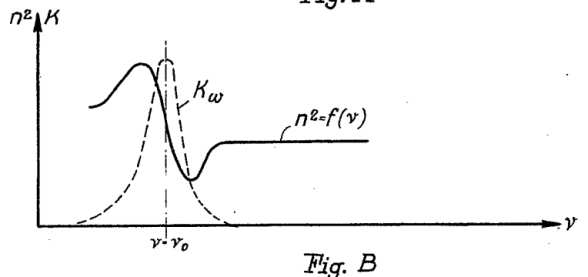
GB417564
[
PDF ]
Improvements in devices for
generating electromagnetic fields oscillating with
quasi-optical frequencies
1934-09-29
Inventor(s): James Y. Johnson
Applicant(s): TERNION AG
Classification: - international:
H03L7/26; H03L7/26 - European: H03L7/26
Abstract -- Electromagnetic fields of quasi-optical
frequencies are generated in the space between two
oppositely-placed electrodes which are excited at one or more of
their natural frequencies by an external high-frequency source.
The electrodes are the seat of electromagnetic waves, after the
manner of Lecher wires, but in two dimensions instead of one. The
apparatus is applied for various purposes, including the chemical,
physical, and biological processes referred to in Specification
417,501. The distribution of electric stress in the dielectric may
be made visible by a polarized-light projection system. Fig. 1
shows a resonator comprising parallel circular plates 1, 2 excited
by high-frequency voltages applied by the conductors 3, 4. The
plates may be of square or rectangular form, and may be inclined
to each other. One or both may be concave or convex on its inner
surface. Current and voltage waves are propagated along the plates
in the same manner as along Lecher wires. With circular plates
excited at their centres and with their rims free, the fundamental
oscillation gives a voltage peak and a current node at the rim. If
the rims are short-circuited by added capacity, as for instance by
inserting the resonator in a metal cylinder 9, Fig. 24, the
voltage peak and current node are at the centre. The plates also
resonate at higher frequencies, with nodal diameters and nodal
concentric circles. With rectangular plates, nodal lines parallel
or oblique to the edges are created. The positions of the nodal
lines may be predetermined by metal blocks 10, Fig. 24, fixed to
the external cylinder 9, or to one of the plates 1, 2. The plates
may be of good conducting metal, or of poorly-conductive metal
with or without a coating of good conductivity; or the
plates may be in the form of containers filled with an
electrolyte. The plates may be light-permeable, consisting of
glass with a very thin coating of precious metal on their inner or
outer faces. One or both plates may also be in the form of wire
grids stretched across rings of insulating material and
electro-plated with copper or silver to provide good conductivity
where the wires cross. The resonator plates are excited by
separate generators of damped or undamped waves. Fig. 25 shows a
valve generator 54 with Lecher-wire output circuit 45, 46 tuned by
a condenser bridge 53, and with the resonator 51, 52 loosely
coupled thereto by two air gaps between small spheres 47--50. The
coupling condensers may take the form of a ball and ring, or of
small parallel plates at adjustable distance. The couplings may be
slidable along the wires 45, 46, and along the resonator plates.
The Lecher wires may be in the form of a wire and concentric tube,
and they may be provided with knot extremities for coupling to the
edge of the resonator plates. By inserting the Lecher wires
between the resonator plates, an inductive coupling may be
provided. In Fig. 32, the concentric-tube Lecher system 99 is
adjusted in length by a trombone slide 108 and is tuned by
reflection bridges 102, 103 placed in the divided branches 100,
100. The coupling conductors 104, 105 of the resonator 106, 107
project into the interior of the conduits. When liquid to be
treated is contained in a glass envelope 128, Fig. 40, placed
between the plates 120, 121 of the resonator, the dielectric is
composed of layers of air glass and liquid. The Specification
discusses the effect of the composite dielectric on the natural
frequencies and the damping of the resonator. The distribution of
electric stress in the liquid may be rendered visible by the
apparatus of Fig. 40. The resonator plates are coupled by rods
122, 123 to Lecher wires 124, 125 fed by a valve generator 126.
Temperature may be regulated by heating-coils 129 within the
casing 130. Light from a source 137 which may be a mercury vapour
lamp is projected through lens 131 , polarizing-prism 133, mica
plates 135 and lens 132 , and after passage through the treated
liquid 128 emerges through similar devices to the screen 138,
giving thereon a picture of the field distribution within the
resonator. If the exciting oscillation is modulated, a complex
varying pattern is produced. Glass or liquid lenses 142, 143, Fig.
41, may be arranged between the container 144 for the liquid under
treatment and the resonator plates 140, 141. If convex as shown
the lenses tend to equalize the field over the whole area whilst
concave lenses concentrate the field in the centre. The lenses may
be attached to the container 144 or the plates 140, 141. The
resonator may be housed in a double-walled cylindrical casing with
external knobs and dials for screw adjustment of the plate gap.
Heating coils and coils for spraying cooling liquids into the
casing are provided. Lecher wires of the concentric type are led
through the container walls to excite the resonator, and high
tension may be applied through chokes. The resonator plates may
take the form of shelves 231--233, Fig. 49, separated by
insulating posts 234, the material to be treated, for example
foodstuffs, being placed upon the shelves. Energy may be led to
the shelves by Lecher wire systems terminating in knobs adjacent
to the edges of the shelves.
[ Nomographs :-- Figure 9 ... Figure 10
... Figure 37 ... Figure
39 ... ]





